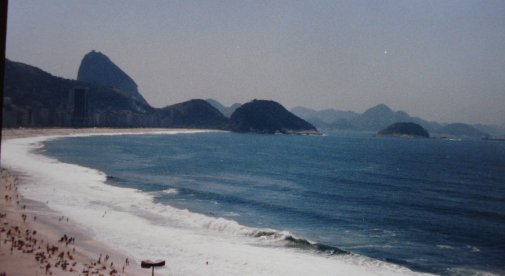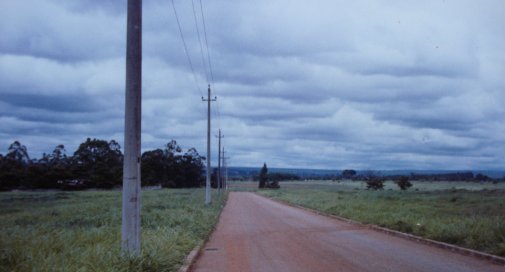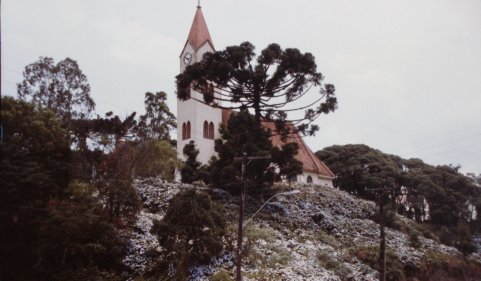Below is Rio. Chrissy & I went there in August, which was winter there. It doesn’t get cold and the water was pleasantly cool. It was fun playing in the waves, but I almost got sucked out by a rip tide. I tried to swim in but found myself farther and farther from land. Then I remembered to swim parallel to shore. Rip tides are like rivers; they are long but usually not wide. We didn’t see much of Brazil. This was our first post and since we were so poor paying off student loans, setting up household etc we only went where the job sent us. Fortunately, travel was a part of my job. Brazil is a beautiful and diverse country.

I was in Brazil when the sugar cane alcohol fuel program was just a few years old. Cities like Rio, Sao Paulo or Porto Alegre sort of smelled like a tavern, not a surprise when the cars are essentially running on rum. I was intrigued by the idea of turning sugarcane into fuel, but I admit that I wasn’t very impressed with the application back in 1985/6. Porto Alegre has a climate like Savannah, Georgia. It rarely got very cold, but it was cold enough to gum up the engines that ran on alcohol. But the Brazilians have overcome these challenges and their thirty-year experiment with alternative fuels seems to have succeeded. They have gone from importing 70%+ of their fuel for their cars to less around 10%, but there is more to the story. I went over to AEI to hear Energy Lessons from Brazil to get the update.
Below is Porto Alegre from the window of our apartment there. Rainbows like that were common.

The speaker explained that the impressive figures were a little deceptive. The Brazilian success came not only from alternative fuels, but also from a lot of old fashioned oil that they discovered offshore. And that was the first lesson from Brazil – you have to do all of the above when it comes to energy.
Brazil has a big advantage in biofuels because the climate is great for growing sugarcane and sugarcane is great for making biofuel. Making fuel from sugarcane is around 8 times more efficient than from corn. In fact, corn probably uses as much or more energy to make a gallon of fuel as it yields, so corn ethanol is more just an energy carrier than source. Beyond that, sugarcane is relatively unmanipulated, i.e. there has been little crop improvement done on cane, so there more scope for easy improvement than there is in corn, which has long been the subject of selection.
Below is Brasilia. The picture is within the city. It was not carved out the jungle, as the myth says. Brasilia was mowed out of the grass. The climate is nice, with a dry season when it never rains and a wet season when it rains every day. I like the rainy season better because it gets very green. There was a lot of space in 1985. I suppose it has grown.

Even with all this, however, low oil prices in the 1990s almost killed the sugarcane experiment. Ethanol from sugarcane is competitive with gas when oil is around $50 a barrel. When oil gets too cheap, it drives out the alternatives, as I have written before.
Alternatives to oil are good for both political and economic reasons. Most of the world’s easily exportable oil is under or near unstable countries often in places where democracy is not viewed with particular enthusiasm. Less dependence on these sorts of places is good. In the Brazilian case (which probably in applicable generally) having the alternative to oil made the economy more stable. More than 90% of the cars sold in Brazil are flex fuel, which means drivers can choose the cheaper fuel, which moderates price changes. Besides that, the alternative fuel employs people within the country, keeping transfers at home instead of bleeding money to various petrostates.
Below is Gramado, north of Porto Alegre. Southern Brazil had a lot of immigrants from Germany and N. Italy and had a very European feel, except for the exotic trees.

We can learn from what the Brazilians pioneered. Some of the technologies and techniques can be applied and adapted to American realities. We need to find a better feedstock than corn for our biofuels, however. I hold out hope for cellulostic ethanol, but nobody can predict the future. Ten years ago, the Brazilian ethanol experiment was floundering; today it is flourishing. In an uncertain world, you have to try all of the above with a wide portfolio of solutions … and be ready to be flexible when some of your favorites don’t work.
P.S. In the Q&A somebody got up and self righteously asked why America with around 5% of the world population should consume 25% of the world’s energy. Somebody always “asks” this question, but it is a silly question and the premise is wrong. Energy consumption is related to output. The U.S. produces around 25% of the world’s output and it consumes a commensurate amount of energy. We need to be more efficient in our use of energy, but we cannot get down to using the same % of energy as our population unless our economy collapses (and probably brings the world down with us) or others in the world catch up.

They call that energy intensity or energy efficiency. Our energy intensity has been improving for the last 40 years, but our economy is growing even faster.
